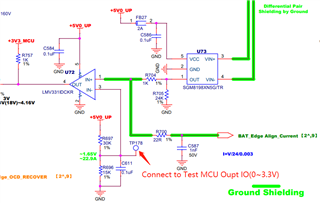Tool/software:
LMV331IDCKR IN- impedance abnormal,about 100R to GND.
Our Circuit as below:

IN- also connect Test MCU output IO(0~3.3V).
Which situation can damage IN- to low impedance?
Thanks!
This thread has been locked.
If you have a related question, please click the "Ask a related question" button in the top right corner. The newly created question will be automatically linked to this question.
Tool/software:
LMV331IDCKR IN- impedance abnormal,about 100R to GND.
Our Circuit as below:

IN- also connect Test MCU output IO(0~3.3V).
Which situation can damage IN- to low impedance?
Thanks!
Thanks for your post and sorry to hear about your experience.
I wish we could be of more assistance, but I don't see anything unusual about your circuit configuration that would lead to damage on the inverting input. What you are describing does sound like electrical overstress, but it is possible that the cause came from a different source than the inverting input. This device is developed on a 5V process, so if there was an unexpected short to voltage above abs max ratings (either in the positive or negative direction), this could result in electrical overstress as you are experiencing. I see mention of ground shielding, so I assume there is some potentially higher voltage sources in close proximity that could potentially cause harm. The best form of protection for any input is series resistance just in case something occurs that is unexpected. If you continue to find similar failures in the future, it would be advised to try probing different pins to see if there is some unexpected coupling of high voltage occurring.
Chuck
Is this IO have diode protection?
There is no description about protection.

Thanks!
The absolute maximum ratings forbid voltages below GND or above VCC+. This implies that there are such clamping diodes (and that an unlimited current through these diodes would destry them). But note that these diodes are designed only for ESD events that happend during automated manufacturing; if the signal lines can be touched by a human, you need more protection.
(Many datasheets specify a limit for the diode current. The LMV331 datasheet does not, but this does not matter for normal operation.)
If only the IN− pin is damaged, then it is likely that the EOS happend on that pin. Does "connect to test MCU" imply that you did connect something there, and that it got touched, or that the connection was hot-plugged? If yes, then I would assume ESD, and that this problem would not happen during normal operation.
Hi yx,
As Clemens said, the voltage range being limited by VCC implies that there is are top and bottom clamps. We have an applications note that goes into the different comparator input types: Comparator Input Types (ti.com)